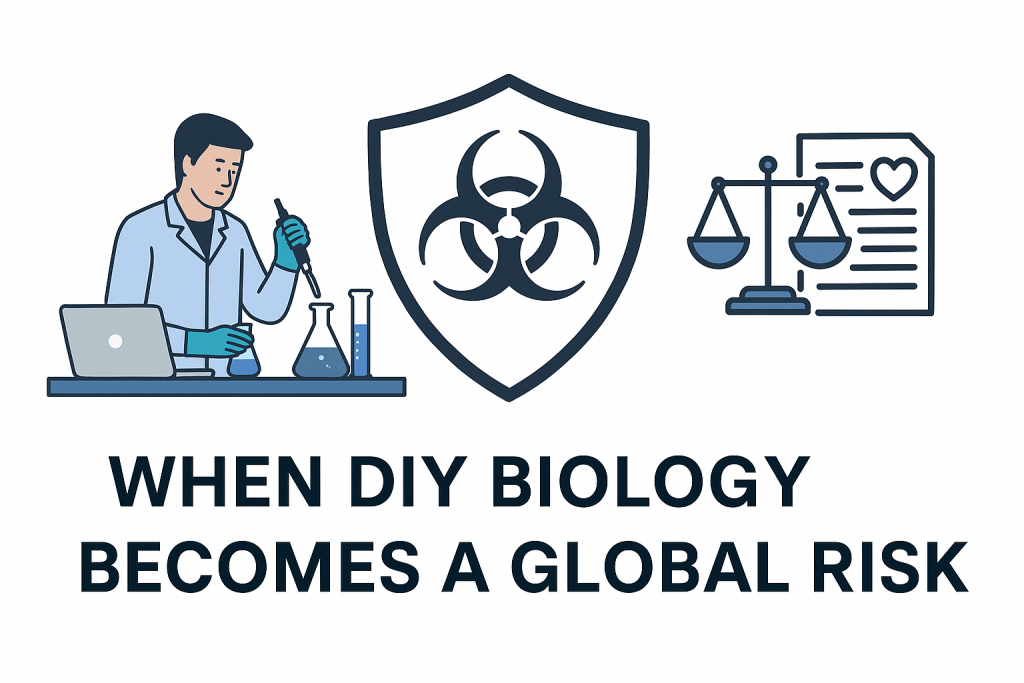The democratization of science is powerful—but biology is not like code. It can spread, evolve, and escape.
The Promise of Citizen Biology
Innovation no longer belongs to institutions.
Across the world, community bio-labs and garage biology collectives are giving everyday people access to tools once reserved for professional researchers. Using cheap DNA synthesis kits, open-source gene editing platforms, and shared lab spaces, citizen scientists are exploring everything from sustainable materials to homemade insulin.
This open biotechnology movement mirrors the early days of personal computing: curiosity-driven, accessible, and decentralized. It’s a powerful engine for education and innovation. But biology, unlike software, operates in the physical and ecological world—and that changes the equation.
From Curiosity to Capability
Biological experimentation has crossed from theoretical to tangible.
What once required a university lab can now be done with consumer-grade tools. Kits for CRISPR gene editing are sold online. DNA sequences can be ordered and shipped globally. Online forums teach lab techniques and genetic design basics.
These developments expand access to science education and creativity—but they also expand the surface area of biological risk.
A small error or intentional misuse in a community lab could, in theory, release an organism with unintended ecological or health effects. Even if unlikely, the cost of failure is high.
Unlike code, biology replicates. Mistakes can multiply, mutate, and move beyond control.
The Hidden Risk: Unregulated Experimentation
The biohacker ethos—“build it yourself”—collides with biosecurity reality.
Many community labs operate responsibly, following local safety protocols and ethical frameworks. But global access to genetic materials and editing tools makes oversight inconsistent.
Key risk vectors include:
- Unscreened DNA synthesis orders that could contain sequences from pathogens.
- Inadequate containment in non-certified lab environments.
- Lack of training in sterilization, disposal, and risk assessment.
- Information sharing that spreads sensitive genetic designs online.
In other words, the barrier to creation has dropped faster than the barrier to control.
Why Biosecurity Education Matters
The first line of defense isn’t regulation—it’s understanding.
Rather than shutting down community bio-labs, the future of safe open biotechnology depends on education and shared ethics.
Effective biosecurity for citizen science should focus on:
- Ethical literacy: Teaching the social and environmental responsibilities of genetic work.
- Risk-level training: Classifying experiments by containment needs and potential harm.
- Community reporting channels: Encouraging peer oversight and transparency.
- Secure design tools: Embedding digital safety features in genetic modeling software.
When participants see themselves as stewards, not just tinkerers, biosecurity becomes culture, not compliance.
Access Control in an Open World
Access is not the same as anarchy.
Open biotechnology doesn’t mean unrestricted use. Thoughtful access control systems—such as identity verification for DNA synthesis orders, safety certification for lab members, and standardized containment practices—can balance openness with accountability.
These systems should be lightweight but firm: enabling creativity while preventing the accidental or intentional creation of harmful organisms. The goal isn’t to limit curiosity—it’s to ensure that curiosity doesn’t become catastrophe.
Designing Safe Innovation
Biosecurity must be built into the design phase, not added afterward.
Software engineers use secure coding practices to prevent vulnerabilities before deployment. Biodesign needs the same mindset. Tools for genetic modeling, synthesis, and assembly can integrate safety checks—flagging sequences that match pathogenic patterns or triggering alerts for dual-use research.
This idea of “ethical-by-design biology” transforms security from an afterthought into a default. It’s how the field can scale responsibly without repeating the mistakes of other innovation waves—like social media or AI—where speed outpaced oversight.
The Way Forward: Shared Stewardship
The future of biotechnology will be defined by how well we manage openness.
Community labs and DIY biologists represent a creative and necessary force in scientific culture. They embody accessibility, experimentation, and local problem-solving. But to prevent innovation from becoming insecurity, the next decade must focus on biosecurity as shared stewardship.
Governments, educators, and citizen scientists must co-create a framework where learning and safety evolve together. The challenge isn’t to restrict biology—it’s to make it self-aware.
Conclusion: A New Kind of Literacy
DIY biology proves that science has left the ivory tower. But in this new landscape, literacy means more than understanding how genes work—it means understanding what responsibility looks like when life becomes programmable.
If the last century taught us to handle power responsibly in the digital realm, this one demands we do the same for the biological. Because in biology, a single act of curiosity can have global reach.


